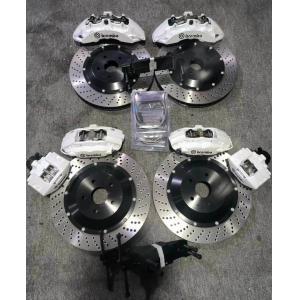
Add to Cart
Fit For Brembo V6 6pot Car Brake Caliper Kits For Toyota Alphard R20 Rim Size
Specification of Fit Brembo V6 Brake Caliper Kits
| Products Name | Toyota Alphard Brake Caliper Kits |
| Function | Reduce Stopping distance |
| Discs Size | 380MM |
| Fit Car | Toyota Crown, Alphard |
| Craft | Fit for Brembo Refurbished Caliper |
| Color | Blue, Gold, Sliver, Customized |
Brake pads are an essential safety component in a car's braking system, and the effectiveness of braking largely depends on the quality of the brake pads.
The composition of brake pads typically includes the following components:
1. Friction Material: This is the main component of the brake pad that comes into contact with the brake disc. It is responsible for generating friction and converting kinetic energy into heat during braking. Friction materials can be organic, semi-metallic, metallic, or ceramic, each with its own characteristics.
2. Bonding Agents: Bonding agents hold the friction material together and attach it to the brake pad backing plate. They provide strength and stability to the brake pad.
3. Backing Plate: The backing plate is a metal component that provides structural support and helps dissipate heat generated during braking. It also serves as a foundation for attaching the friction material.
When selecting brake pads according to your needs, consider the following factors:
1. Performance: Different brake pad materials offer varying levels of performance in terms of braking power, fade resistance, and noise levels. Consider your driving style, vehicle type, and the desired braking performance (e.g., everyday driving, high-performance driving) to choose the appropriate brake pad material.
2. Noise and Dust: Some brake pad materials may produce more noise or dust than others. If minimizing noise or dust is a priority for you, consider brake pads that are designed for quiet operation or low dust generation.
3. Longevity: Brake pads have different wear rates, and their longevity depends on various factors. Consider the expected lifespan of the brake pads and choose a material that aligns with your preferences and budget.
4. Driving Conditions: Consider the driving conditions you typically encounter, such as city driving, highway driving, or off-road driving. Certain brake pad materials may perform better under specific conditions, such as high temperatures or wet environments.
It's essential to consult with a qualified mechanic or refer to your vehicle's manufacturer recommendations to ensure you choose the right brake pads that meet your specific requirements and are compatible with your car's braking system.

Customer's order:


